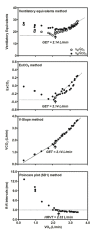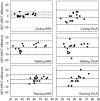Influence of exercise modality on agreement between gas exchange and heart rate variability thresholds
- PMID: 25003546
- PMCID: PMC4165298
- DOI: 10.1590/1414-431x20143713
Influence of exercise modality on agreement between gas exchange and heart rate variability thresholds
Abstract
The main purpose of this study was to investigate the level of agreement between the gas exchange threshold (GET) and heart rate variability threshold (HRVT) during maximal cardiopulmonary exercise testing (CPET) using three different exercise modalities. A further aim was to establish whether there was a 1:1 relationship between the percentage heart rate reserve (%HRR) and percentage oxygen uptake reserve (%VO2 R) at intensities corresponding to GET and HRVT. Sixteen apparently healthy men 17 to 28 years of age performed three maximal CPETs (cycling, walking, and running). Mean heart rate and VO2 at GET and HRVT were 16 bpm (P<0.001) and 5.2 mL · kg(-1) · min(-1) (P=0.001) higher in running than cycling, but no significant differences were observed between running and walking, or cycling and walking (P>0.05). There was a strong relationship between GET and HRVT, with R2 ranging from 0.69 to 0.90. A 1:1 relationship between %HRR and % VO2 R was not observed at GET and HRVT. The %HRR was higher during cycling (GET mean difference=7%; HRVT mean difference=11%; both P<0.001), walking (GET mean difference=13%; HRVT mean difference=13%; both P<0.001), or running (GET mean difference=11%; HRVT mean difference=10%; both P<0.001). Therefore, using HRVT to prescribe aerobic exercise intensity appears to be valid. However, to assume a 1:1 relationship between %HRR and % VO2 R at HRVT would probably result in overestimation of the energy expenditure during the bout of exercise.
Figures



Similar articles
-
Can Heart Rate Variability be used to Estimate Gas Exchange Threshold in Obese Adolescents?Int J Sports Med. 2015 Jul;36(8):654-60. doi: 10.1055/s-0034-1398654. Epub 2015 Apr 1. Int J Sports Med. 2015. PMID: 25831404
-
Adjustment for gas exchange threshold enhances precision of heart rate-derived VO2 estimates during heavy exercise.Appl Physiol Nutr Metab. 2008 Feb;33(1):68-74. doi: 10.1139/H07-133. Appl Physiol Nutr Metab. 2008. PMID: 18347655
-
Relationship Between Percentages of Heart Rate Reserve and Oxygen Uptake Reserve During Cycling and Running: A Validation Study.J Strength Cond Res. 2019 Jul;33(7):1954-1962. doi: 10.1519/JSC.0000000000002079. J Strength Cond Res. 2019. PMID: 28658083
-
Physiological differences between cycling and running: lessons from triathletes.Sports Med. 2009;39(3):179-206. doi: 10.2165/00007256-200939030-00002. Sports Med. 2009. PMID: 19290675 Review.
-
The Conconi test: methodology after 12 years of application.Int J Sports Med. 1996 Oct;17(7):509-19. doi: 10.1055/s-2007-972887. Int J Sports Med. 1996. PMID: 8912066 Review.
Cited by
-
Heart Rate Variability-Derived Thresholds for Exercise Intensity Prescription in Endurance Sports: A Systematic Review of Interrelations and Agreement with Different Ventilatory and Blood Lactate Thresholds.Sports Med Open. 2023 Jul 18;9(1):59. doi: 10.1186/s40798-023-00607-2. Sports Med Open. 2023. PMID: 37462761 Free PMC article.
-
Agreement Between Heart Rate Variability - Derived vs. Ventilatory and Lactate Thresholds: A Systematic Review with Meta-Analyses.Sports Med Open. 2024 Oct 8;10(1):109. doi: 10.1186/s40798-024-00768-8. Sports Med Open. 2024. PMID: 39379776 Free PMC article.
-
Reliability of the heart rate variability threshold during treadmill exercise.Clin Physiol Funct Imaging. 2022 Jul;42(4):292-299. doi: 10.1111/cpf.12760. Epub 2022 May 19. Clin Physiol Funct Imaging. 2022. PMID: 35524470 Free PMC article.
References
-
- Garber CE, Blissmer B, Deschenes MR, Franklin BA, Lamonte MJ, Lee IM, et al. American College of Sports Medicine position stand. Quantity and quality of exercise for developing and maintaining cardiorespiratory, musculoskeletal, and neuromotor fitness in apparently healthy adults: guidance for prescribing exercise. Med Sci Sports Exerc. 2011;43:1334–1359. doi: 10.1249/MSS.0b013e318213fefb. - DOI - PubMed
-
- ACSM. ACSM's guidelines for exercise testing and prescription. 8th edn. Baltimore: Lippincott Williams & Wilkins; 2009.
-
- Davis JA. Anaerobic threshold: review of the concept and directions for future research. Med Sci Sports Exerc. 1985;17:6–21. - PubMed
-
- Wasserman K, Whipp BJ, Koyl SN, Beaver WL. Anaerobic threshold and respiratory gas exchange during exercise. J Appl Physiol. 1973;35:236–243. - PubMed
-
- Whipp BJ, Ward SA, Lamarra N, Davis JA, Wasserman K. Parameters of ventilatory and gas exchange dynamics during exercise. J Appl Physiol Respir Environ Exerc Physiol. 1982;52:1506–1513. - PubMed
Publication types
MeSH terms
LinkOut - more resources
Full Text Sources
Other Literature Sources
Miscellaneous

